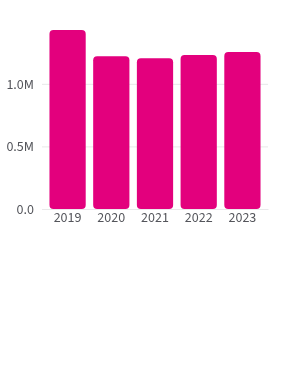How many states use private prisons?
More than half of states used private prisons in 2022, but they housed less than 10% of all inmates nationwide.
As of 2022, 28 states used privately run prisons along with (or instead of) local jails and state-run facilities. That same year, 7.4% of prisoners were in a private facility.
In January 2021, former President Joe Biden signed an executive order ending the use of privately-operated prisons, citing importance of prisoner rehabilitation and redemption and the need to alleviate federal reliance on profit-based correctional systems and noting that privately-operated prisons underperform in terms of both inmate and staff safety and resources for inmates.
The Federal Bureau of Prisons ended the use of privately-owned prisons on November 30, 2022. As of 2025, there are zero federal inmates in private institutions.
But because the order only applied to federal prisons, states can continue to contract with for-profit prisons.
What is a private prison?
Correctional institutions include jails and prison facilities housing inmates under local, state, or federal jurisdiction. When a government agency signs a contract with a third party to run a prison, that’s a private or “for-profit” prison.
Which states have the most inmates in private prisons?
As of 2022, the most recent year of federal data, Montana was most reliant on for-profit prisons. It housed nearly half of its prisoners (49.4%) in private facilities.
Montana was an outlier: percentages of the next-closest states were nearly 20 points behind. New Mexico housed 30.6% of its prison population in private facilities, while Arizona and Tennessee each housed 28.8%. Hawaii followed with 23.3%.
In the remaining 23 states with private prisons, the percentage of inmates under private custody ranged from 0.1% to 18.7%.
Illinois banned private prisons in 1990 but housed 1.1% of prisoners in privately-run facilities as recently as 2022. The Bureau of Justice Statistics notes that Illinois data includes inmates who are part of a third-party work-release program, where people remain in custody as they transition back to life outside of the correctional system.
Which states do not use private prisons?
As of 2022, twenty-two states did not use private prison facilities: Arkansas, California, Delaware, Iowa, Kansas, Louisiana, Maine, Maryland, Massachusetts, Michigan, Minnesota, Missouri, Nebraska, Nevada, New Hampshire, New York, Oregon, Rhode Island, Utah, Washington, West Virginia, and Wisconsin.
Only some states have legislation banning private prisons. Not using private facilities does not imply a formal ban. In some cases, like Minnesota, the formal ban came after 2022 data was collected. Missouri banned private prisons in 2001.

Where are prisoners if they’re not in private prisons?
Most are in state-run jails. In 2022, an average of 87.2% of prisoners were in a state-run facility. Seven states used state-run jails only: California, Delaware, Maine, Michigan, Missouri, New York, and Rhode Island. The remaining prisoners are in local jails.
Louisiana was the only state to house more inmates in local jails (52.7%) than in state-run jails (47.3%).
There is little federal data on how many private prisons there are in each state. The most recent federal report on the number of private prison facilities is from a Bureau of Justice Statistics report from 2019.
Learn more about how much states spend on prisoners and get the data straight to your inbox with our weekly newsletter.
Keep exploring
Page sources
Bureau of Justice Statistics
Prisoners in 2022 – Statistical Tables
